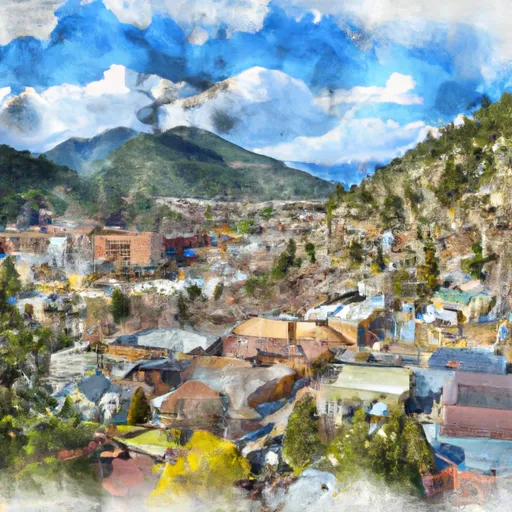-
 Snoflo Premium
Snoflo Premium
Get unlimited access to all our content
With no Ad interruptions! - Start Your Free Trial Login with existing account
Idaho-Springs
Eden Index
Climate
6.7
•
Recreation
7.5
•
Community
1.6
•
Safeguard
5.7/10

Idaho Springs is a charming town located in Clear Creek County, Colorado. Situated at an elevation of 7,526 feet, it offers a mild alpine climate with cool summers and cold winters. The average high temperature in summer is around 75°F (24°C), while winter temperatures can drop to 20°F (-7°C). Idaho Springs receives an average of 23 inches of snowfall annually, making it an ideal destination for winter sports enthusiasts.
The town is also known for its hydrology constituents, primarily due to Clear Creek, a tributary of the South Platte River, which flows through the area. The water in Clear Creek is rich in minerals, including gold, and has played a significant role in Idaho Springs' history as a mining town during the Colorado Gold Rush.
Idaho Springs offers a plethora of outdoor recreation opportunities. Visitors can explore the nearby Arapaho National Forest, renowned for its hiking and biking trails, camping spots, and scenic vistas. The area is also popular for whitewater rafting and fishing, with Clear Creek providing opportunities for both activities. Additionally, the nearby Echo Mountain Ski Resort offers skiing and snowboarding opportunities during the winter months. Whether it's exploring nature or enjoying thrilling adventures, Idaho Springs has something for everyone.
What is the Eden Index?
The Snoflo Eden Index serves as a comprehensive rating system for regions, evaluating their desirability through a holistic assessment of climate health, outdoor recreation opportunities, and natural disaster risk, acknowledging the profound impact of these factors on livability and well-being.
Climate Health Indicator (CHI): 6.7
Idaho-Springs receives approximately
442mm of rain per year,
with humidity levels near 50%
and air temperatures averaging around
5°C.
Idaho-Springs has a plant hardyness factor of
5, meaning
plants and agriculture in this region thrive during a short period during spring and early summer. Most
plants will die off during the colder winter months.
By considering the ideal temperature range, reliable water supplies, clean air, and stable seasonal rain or snowpacks, the Climate Health Indicator (CHI) underscores the significance of a healthy climate as the foundation for quality living.
A healthy climate is paramount for ensuring a high quality of life and livability in a region, fostering both physical well-being and environmental harmony. This can be characterized by ideal temperatures, reliable access to water supplies, clean air, and consistent seasonal rain or snowpacks.
Weather Forecast
Streamflow Conditions
South Platte
Area Rivers
South Platte
Snowpack Depths
South Platte
Reservoir Storage Capacity
South Platte
Groundwater Levels
Recreational Opportunity Index (ROI): 7.5
The Recreational Opportunity Index (ROI) recognizes the value of outdoor recreational options, such as parks, hiking trails, camping sites, and fishing spots, while acknowledging that climate plays a pivotal role in ensuring the comfort and consistency of these experiences.
Access to outdoor recreational opportunities, encompassing activities such as parks, hiking, camping, and fishing, is crucial for overall well-being, and the climate plays a pivotal role in enabling and enhancing these experiences, ensuring that individuals can engage in nature-based activities comfortably and consistently.
Camping Areas
| Campground | Campsites | Reservations | Toilets | Showers | Elevation |
|---|---|---|---|---|---|
| Eleven Mile State Park | 350 | 8,616 ft | |||
| Riverside | 18 | 8,052 ft | |||
| Molly Gulch | 15 | 7,490 ft | |||
| Blue Mountain | 21 | 8,079 ft | |||
| Goose Creek | 10 | 7,701 ft | |||
| Spruce Grove - Lake George | 27 | 8,510 ft | |||
| Springer Gulch | 15 | 8,324 ft | |||
| Twin Eagles | 9 | 8,547 ft | |||
| Happy Meadows | 8 | 7,879 ft | |||
| Round Mountain | 15 | 8,531 ft |
Nearby Ski Areas
Catastrophe Safeguard Index (CSI):
The Catastrophe Safeguard Index (CSI) recognizes that natural disaster risk, encompassing floods, fires, hurricanes, and tornadoes, can drastically affect safety and the overall appeal of an area.
The level of natural disaster risk in a region significantly affects safety and the overall livability, with climate change amplifying these risks by potentially increasing the frequency and intensity of events like floods, fires, hurricanes, and tornadoes, thereby posing substantial challenges to community resilience and well-being.
Community Resilience Indicator (CRI): 1.6
The Community Resilience Indicator (CRI) recognizes that education, healthcare, and socioeconomics are crucial to the well-being of a region. The CRI acknowledges the profound impact of these elements on residents' overall quality of life. By evaluating educational resources, healthcare accessibility, and economic inclusivity, the index captures the essential aspects that contribute to a thriving community, fostering resident satisfaction, equity, and social cohesion.

